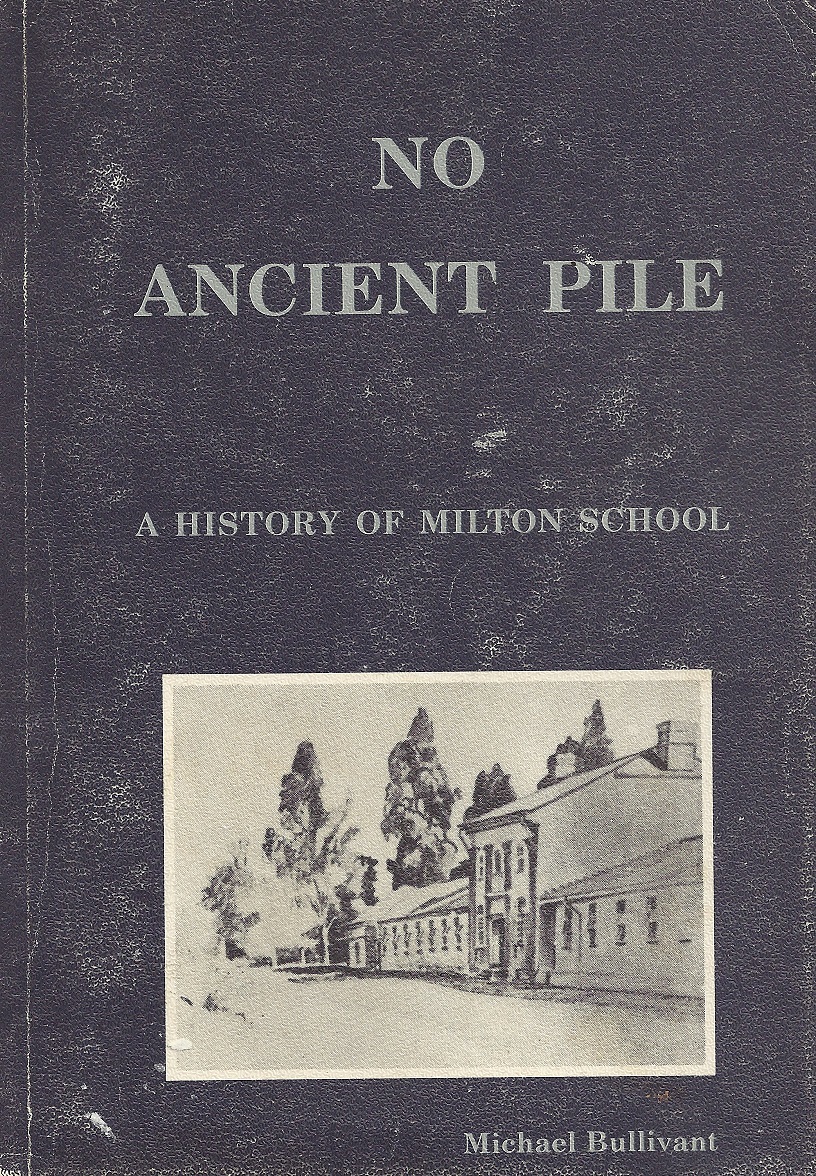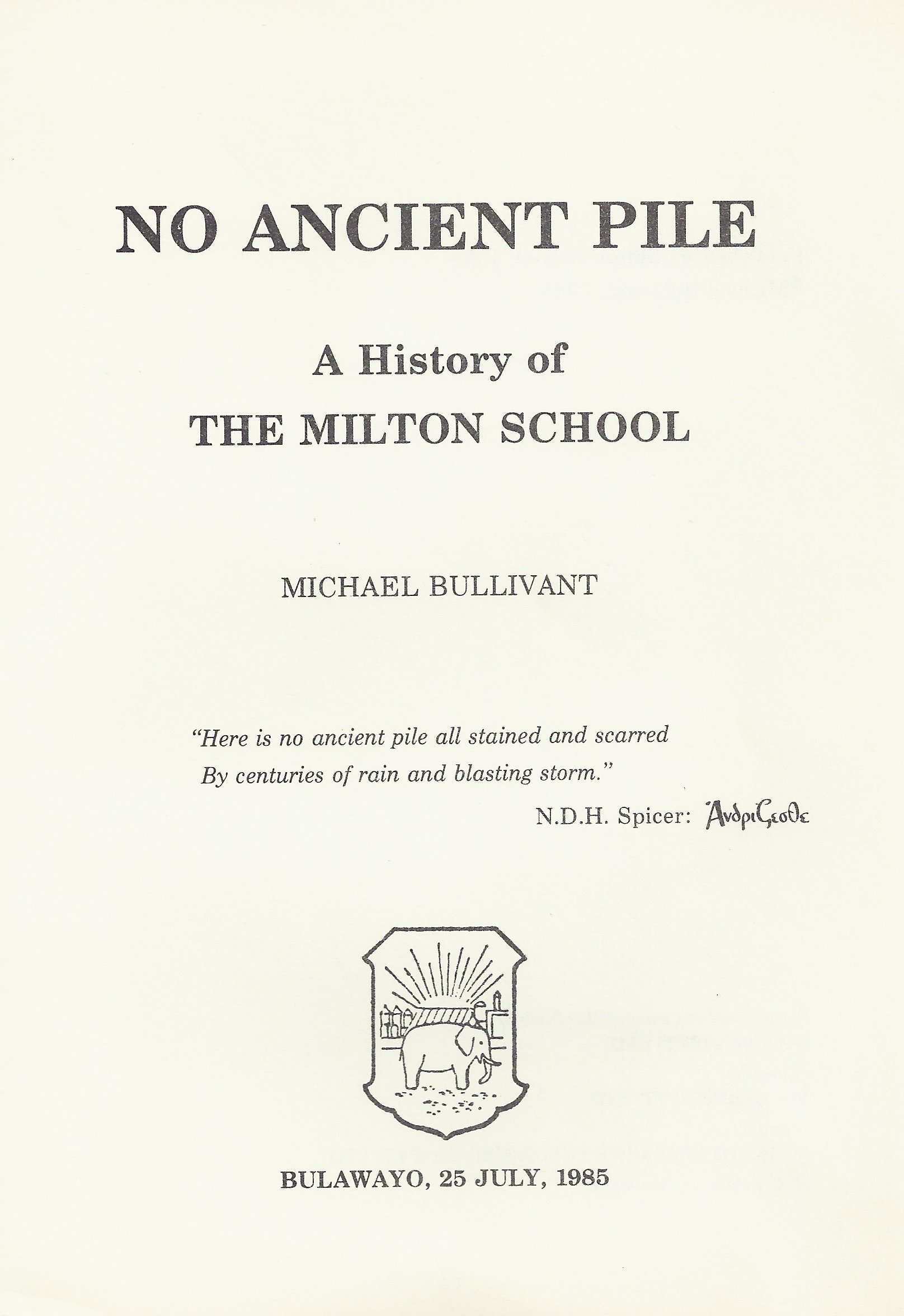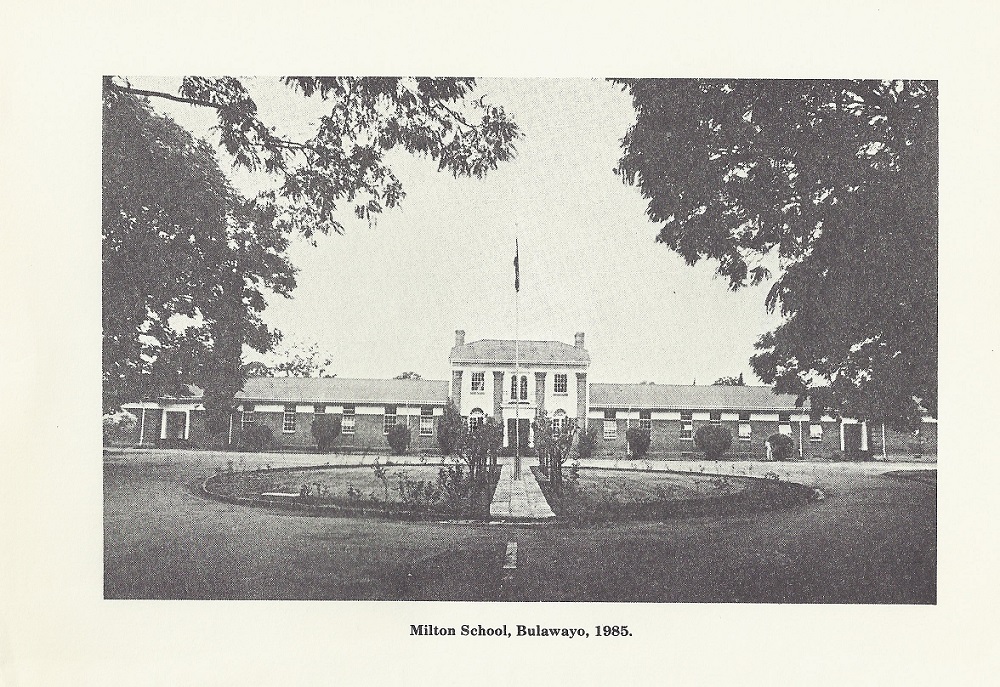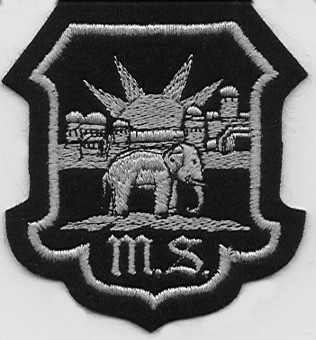No Ancient Pile by kind permission Michael Bullivant (author)
NO ANCIENT PILE
A History of Milton School
M F Bullivant
Michael Bullivant, who contributed a distinguished monograph on Milton
to "Renowned Rhodesian Schools" has now published a full scale history
to mark the School's 75th Anniversary. It is a work which should be on
the shelves of every Miltonian!
The "prehistory" of Milton is dealt with at greater length. I learnt a
lot about the political pressures which led to the closing of St. John's
School. But a close connection continued between St. John's Church and
Milton so long as the latter remained in Borrow Street. Archdeacon
Harker, whose rectory was opposite the school worked closely with the
first Head, de Beer, who sent him as many choristers as he required and
rewarded boarders who went to Sunday church with a bacon and egg
breakfast.
School historians have difficulty in maintaining interest once the rough
and tumble of the pioneering days has been left behind. (Milton boarders
used to need a punt to cross the quad in the rainy season). One
distinguished head succeeds another, a hostel goes up here, a playing
field is laid out there - and the reader dozes gently off. Michael has
avoided bathos by including a mass of colourful detail, much of it in
the appendix to each chapter entitled "Odds & Ends"; and his obvious
enthusiasm for and pride in the school holds the reader's attention.
Eulogies are restrained, and the occasional squeeze of lemon (usually at
the expense of the Ministry of Education) saves the mixture from
becoming over rich. It is humiliating for a reviewer to have to admit
that he cannot put his finger on any faults, but that is now my
predicament. Speaking personally, as one who shares the first head's
indifference to organized sport, I could have spared some of the long
tale of sporting successes to learn what was going on in the classrooms,
the slow slide for example, from the humanities to the natural sciences.
(Not but what, as late as 1968, the school could still produce a
magnificent Latin howler). And why, from Michael of all men, do we hear
so little of Milton music.
My other grouse concerns modern education in general. The author
gleefully records the so-called "sparetime" activities which are always
being added to the curriculum. Fair enough; except that religion is not
one of them. Anyone who tries to organise a confirmation class soon
discovers the modern child has no spare time. "Leisure activities" have
destroyed leisure.
There remains however, one resort for the frustrated reviewer. Ignoring
the banquet provided, he may loudly demand further courses (These may
require months of further research - but who cares about that?)
Very well then; in these sociological days, we are told very little
about the impact of Milton School on the nation at large or the city.
For example: Plumtree School has often been called the nursery of the
Rhodesian Front (I hope that is not an indelicate remark). Did Milton
contribute MP's to the Front or some other party? How many OM's have
been chosen as alderman or mayors, or served on the Bulawayo City
Council?
What professions or careers has, say, the class of 1960 taken up? How
many have emigrated and where to? Do Miltonians tend to marry Evelyns or
is Townsend or the Convent preferred? Do their sons follow them to
Milton or has zoning put a stop to all that?
That should keep the author happily occupied until he has produced a
second edition, But, if not, I promise to think up some further
conundrums, any time he asks.
The book contains many photographs and ends with six appendices; that on
"Milton at War" describes some enthralling adventures of OM's in World
War II. Michael has certainly done his part in making "Milton, a name of
resound of ages".
RAB EWBANK
DEAN OF BULAWAYO
The complete edition
Chapter
- St. John’s School,
1898 – 1910 ................
Page 1
- Dab’s School,
1910 – 1924 .................
Page 11
- Colonel Brady and "The New School",
1925 – 1930 ................
Page 20
- Livingston and the "Modern Side",
1930 – 1939 ................
Page 28
- War and Peace - and Expansion,
1939 – 1955 ................
Page 48
- Messiter-Tooze and the Golden Jubilee, 1956 –
1963 ................
Page 57
- Brett and Academic Excellence,
1964 – 1969 ................
Page 68
- "The Leading Boys' School",
1970 – 1985 ................
Page 77
AFTERWORD - The Seventy-fifth Birthday
.......................................
Page 97
APPENDIX A - The Milton Sonnet
.....................................................
Page 100
APPENDIX B - The First Milton Address
...........................................
Page 103
APPENDIX C - Milton Verse
..............................................................
Page 111
APPENDIX D - Milton at War
............................................................
Page 127
APPENDIX E - Pat Judson
.................................................................
Page 154
APPENDIX F - Lists and Tables
.........................................................
Page 159



'NO ANCIENT PILE' -
ERRATA
As no second edition of 'No Ancient Pile' seems
likely much before the centenary in 2010, it is perhaps appropriate to
list some corrections prior to that date! The following have been
brought to my attention by various people and are all, I think, of
interest - any further amendments for future publication will be
welcomed.
Robin Ewbank, Dean of Bulawayo, contributed the
following note:
'On page 4 of "No Ancient Pile" we read that Rhodes
distributed the end-of-year prizes at St. John's in 1900. Further
research shows this is not quite accurate.
'There was no prize-giving at the end of 1900 for
the sufficient reason that there were no prizes. The war had prevented
their arrival from Cape Town. 'It was decided to hold the ceremony on
21st June 1901 which was the last day of the second term and shortly
before the Nativity of St. John Baptist. Rhodes happened to be in
Bulawayo that week and at the last moment agreed to distribute the
prizes.
'The pupils, 123 in number, were drawn up on a
stage erected over the choir-stalls in the church and were revealed when
the curtain which separated chancel from nave was drawn back. They gave
an entertainment - songs, recitations, comic dialogues, musical drill -
which the reporter from the Chronicle found more interesting than he
expected.
'Wimbush, the Rector, was in the Chair and
introduced the guest of honour. Over sixty pupils, half the school,
received prizes, and Rhodes, who had only nine months to live, gave
rather a rambling speech.
'He praised the Right-of-Entry system which he said
was unique in this country. For example, at St. John's there were twenty
Jewish children whom the Rabbi instructed. He then enlarged upon the
benefits of state-provided education, if combined with the Right of
Entry. This part of his speech can hardly have been agreeable to those
who were struggling to build up St. John's as a denominational school.
'However, the children gave three cheers for the
speaker who next day left Bulawayo, never to return.'
Facing P.40 is a photograph of H.R.H. Prince George
inspecting cadets and in the text on P.46 this occasion is referred to
with the bracketed note that the Prince. Later became King George VI.
This is quite wrong: H.R.H. Prince George was, of course, the Duke of
Kent who was killed in an air crash in 1942; the future George VI was
Prince Albert – he took the name George on succeeding to the throne in
honour of his father, but remained 'Bertie' to family and friends until
his dying day.
The illustration of the interior of the Dining Hall
in 1929 printed between pages 38 and 39 has been reversed, as reference
to the 1985 view between pages 96 and 97 will show.
The photograph of the West Wing of the School and
Charter house in the early 1940's, between pages 48 and 49, is probably
misdated; the car in the picture is almost certainly Colonel Brady's
which means that the photograph in all likelihood was taken by 1930.
This in turn casts suspicion on the dates of the other photographs in
this group as it would seem that all of them were taken at the same
time.
The list of Selous prizewinners on P.169 ends in
1936; there were in fact two further winners. both in 1951: M G H Yates
and R G Stephens - who is now Chairman of the School Council. The two
names were omitted from both Honours Boards and books and the earlier
omission will be rectified very shortly. The Selous Prize was a
prestigious essay competition whose subjects were to be related to the
open air, wild life etc. matters close to the benefactor's heart.
Although the winning essayist only received a book, his school was more
generously treated, gaining £100, no inconsiderable sum even in 1951.
MICHAEL BULLIVANT
Illustrations
The nave of St. John's, c.1900
St.
John's Church,
c.1899
St.
John's School,
1906
Milton
High School,
1910
Milton House,
1911
Sir
William Milton
E.B. De
Beer
The
First
XV,
1913
The Staff of Milton High School, c.1921
The Calvary,
St.
John's Cathedral
St. John's
Choir Outing,
c.1920
Lt. Col.
J.B.
Brady, D.S.O
"The
Prince
of Wales
with his
Miltonian Shooting Party",
July 1925
The Laying of the Foundation Stone, 5 August 1926
Building a School, 1927
Milton School Prefects, 1926
Sir John
Chancellor inspects the
Cadets
Sir
John
Chancellor unveils the portrait of
Alfred Beit
The
Main
School Block,
1929
The Main School Entrance, 1929
The Beit Memorial Hall, 1929
The War Memorial, 1929
Charter House, 1929
The Dining
Hall
-
Exterior,
1929
The
Dining
Hall
-Interior,
1929
House Common Room, 1929
School Library, 1929
A
Form Room,
1929
Practice
at
the Cricket Nets, 1929
Inspection of "G" Platoon by
H.R.H. Prince George
Aerial View
of
Milton from
Selborne Avenue,
1936
Aerial View
of
Milton from
Townsend Road,
1936
Aerial View
of
Milton from
Selborne Avenue,
1941
Aerial View
of Hostels,
looking north,
c.1945
The Rainy
Season, early
1940s
The
Beit
Hall from
the Main
Quad, early
1940s
The Dining
Hall and
Pioneer House,
early
1940s
The West Wing of the School and Charter House, early 1940s
H.G. Livingston
L.R. Morgan
W. Gebbie
A. Ball
Classrooms,
1951
Classrooms erected in 12 days by Les Playford, 1951
Golden Jubilee
Speech Day,
1960
J.H.
Downing
C.R. Messiter-Tooze
The Opening of the Sixth Form
Centre, 1961
P.M. Brett
R.K.
Gracie
Aerial View of Milton from Selborne Avenue, 1958
Aerial View of Milton from Selborne Avenue, 1978
Aerial View of Milton from the Playing Fields, 1978
Aerial View of Milton from the Thompson Fields, 1978
E. Andersen
H. Fincham
The Original
Badge and
the Present
One
The Deputy Prime Minister demonstrates the marimbas, 1983
Pat Judson
